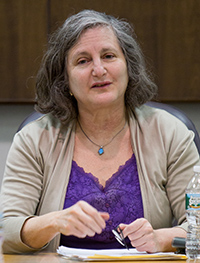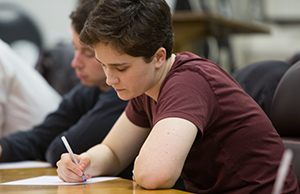

Healerís Art
The Art of Healing: An Elective for Future Physicians
Thirteen medical students sat around an oval table headed by Dr. Ellen Tattelman, course instructor for the The Healer's Art elective. To begin, she introduced some breathing exercises, encouraging the students to relax and feel a sense of peace. Since this particular evening's session focused on "Sharing Grief and Honoring Loss," Dr. Tattelman instructed the students to reflect upon a time of personal disappointment or loss.

Ellen Tattelman, M.D. leading a discussion during The Healer’s Art electiveShe then told them, "Admitting to having feelings of grief and loss can be met with disapproval. Yet acknowledging grief and loss can actually be used for growth. By accepting these feelings, it is possible to help ourselves and, in turn, our patients to deal with loss. Although we cannot fix a loss, most losses can heal."
She concluded, "Following your intuition about what helped you through times of loss can help you be a better physician."
Dr. Tattelman, assistant professor of family and social medicine at Einstein and director of the faculty development fellowship at Montefiore Medical Center, Einstein's University Hospital and academic center, introduced the Healer's Art as an elective in 2002; initially offered to only first- and second-year medical students, the four-week elective is now open to all medical students. "When I worked with residents, I noticed a cynicism and negativity in them that concerned me. It was so far removed from the openness and optimism of students," she said. "So I established the course with hopes that it could provide students with insights and practices that will allow them to retain their original values and compassion."
For Tommy Wilson, a second-year M.D.-Ph.D. student, the insights offered during course sessions truly resonate. "It's important that we never lose sight of our human side. But, at the end of all of the studying, training and stress, perhaps it's a side that gets underutilized or forgotten."
In another session, "Allowing Awe and Mystery in Medicine," the course's three preceptors took turns describing remarkable instances they had encountered while taking care of patients. Like the terminally ill patient who seemingly clung to life long enough to allow a loved one the opportunity to say good-bye.
"Embracing the mystery and awe in life helps to prevent the exhaustion and grind of medicine," said one preceptor, Dr. Fernando Camacho, clinical assistant professor of medicine at Einstein and an attending physician at Montefiore.
He recalled, "I was caring for a patient with terminal cancer whose disease could no longer be helped by science. As a physician, I felt helpless because there was nothing more medically that I could do." He paused and looked at the students around the table. "But sometimes, even if you can't take away the pain, you can still help your patients with their journey."
He related that the patient, grateful for the compassion that Dr. Camacho had shown him, said, "Thank you for helping me walk on broken glass."
As part of this particular session, the students were encouraged to begin a journal to record experiences that have touched and inspired them, to help them remember the awe in life.
Inviting Introspection

During a writing exercise, students were encouraged to record experiences that have touched or inspired themFollowing the one-hour discussion that opens each of the four course sessions, the group breaks into three smaller groups, each under the guidance of a faculty preceptor. Rounding out the trio of instructors is Dr. Peter Selwyn, professor of family and social medicine at Einstein, chair of department at both Einstein and Montefiore, and director of Community Health and Wellness at Montefiore.
"The small group sessions provide a safe space to explore some of the things that may be unexplored by the traditional medical school curriculum, to ask, for instance, how the oncologist grieves," explained Mr. Wilson. "It's really an invaluable opportunity to peer into the heart of medicine."
The small groups also allow time for addressing thoughts or emotions that come up during the reflection exercises. "Those moments of reflection are what keeps my passion for medicine alive," said first-year student Evan Tamura. "It's gratifying to have practicing physicians share insights into their personal challenges and how they maintain a satisfying work-life balance. And, while the course has enhanced my awareness of the challenges of the health profession, I leave each session feeling incredibly relaxed and eager to continue challenging myself."
For fellow first-year Peter Kahn, "Sharing Thursday nights with Dr. Selwyn has been the highlight of my entire year in medical school. As a group, we're students for whom medicine is an outgrowth of a desire to develop profound connections with patients and colleagues, and the course helps us make those connections."
The course emphasizes for students that the humanity of patients is key to success in medicine and that embracing their own humanity can help them become more compassionate physicians and healers. "This elective reminds us that our most valuable tool as healers is our humanity," said Mr. Wilson.
He added, "I hope that this exploration into this side of myself will make me a more gracious clinician in terms of patient care and interaction and also a more graceful person, at peace with and humbled by my role in the lives of those who trust me with their care."
The Healer's Art course was conceived by Dr. Rachel Naomi Remen in 1991, at the University of California, San Francisco School of Medicine. Since then, approximately 70 medical schools, throughout the United States and internationally, have adopted and offered the course.
Posted on: Friday, April 12, 2013

Tablet Blog